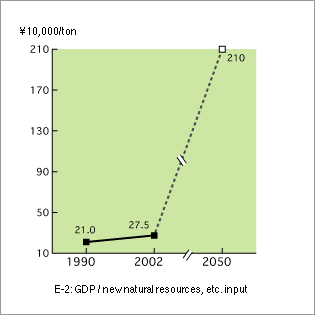ProjectsPast and current JFS projects
Indicators - Economy / Resource Productivity
E-2. Resource Productivity (GDP/Amount of Virgin Natural Resources Input)
1.Current ValuesApproximately 275,000 yen (U.S.$ 2,400) / ton (FY 2001)
(U.S.$=115 yen as of March 2006)
2.Current Points
(out of a perfect score of 100 by 2050) 3 points
Calculation method:
(Current value - minimum value) / (2050 target value - minimum value) x 100
3. Explanation of Indicator
The OECD countries, accounting for 20% of the world's population, currently utilize 80% of the world's resources; international conflicts over ensuring resources are sharpening. Furthermore, excessive use of fossil fuels causes problems such as resource ("source") depletion or global warming and climate change due to greenhouse gasses exceeding the amount permitted by the sinks, such as forests and oceans, that can absorb them. In order to maintain and expand the economy within the permissible limits of both "sources" and "sinks" and do so in such a way as to lower the environmental burden, a dramatic improvement in resource productivity is imperative. That is why we have chosen "resource productivity" as an indicator to show how high a GDP might be attained with how small a natural resource input.
4.Target for 2050
Approximately 2.1 million yen / ton (approx. U.S.$ 18,300)
5.Ideal for the Future
4.2 million yen / ton (approx. U.S.$ 36,500)
6. Rationale for Ideal and Target Values
The Japanese Ministry of the Environment's Fundamental Plan for Establishing a Sound Material-Cycle Society is touting a target value for 2010 of 390,000 tons, which would be almost double ("Factor 2") that of 1990. At the same time, Germany's Wuppertal Institute for Climate, Environment and Energy estimated (in 1991) that the advanced nations will have to attain F10 by 2050 (compared to 1990). With the world population doubling by 2050, this means that global CO2 emissions will need to be halved, and the amount of resources will have to be an equal utilization level throughout the world (a load of 2/5). If the environmental load is to be reduced to one half of what it was 1990, F20 will be needed. Prof. Brezet of The Netherlands (Delft University of Technology) believes that product improvement, redesign, function reforms, and reforms of social systems can lead to F2, F5, F10 and F20 respectively. In keeping with these arguments, JFS has set its 2050 target at Factor 10 and its ideal at Factor 20.
7. Source
Japanese Ministry of the Environment, Material Flows and Material Flow Indicators in Japan for Fiscal 2001
8. Notes
Shows how much economic value was created by virgin natural resources input and by energy input.



